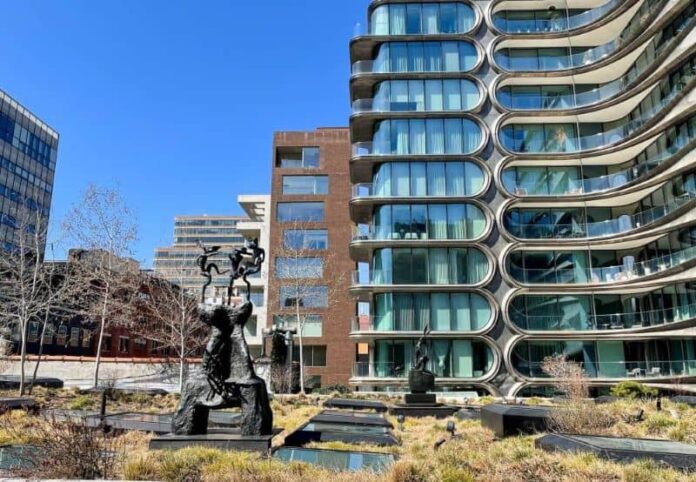While there is more to do in New York than just about any city in America, there are relatively few attractions in NYC that will cost you absolutely nothing. The city’s wonderful parks certainly top this list—and the most unique among these is undoubtedly the High Line, a perennial favorite among locals and tourists alike. Whether you’ve walked the High Line a hundred times before or are gearing up to take your first stroll along the city’s beloved elevated greenway, we have plenty of tips to help you take full advantage of everything the High Line has to offer.
History of the High Line
Today’s High Line is constructed on the remains of an elevated rail line that was erected in the early 1930s as part of the historic West Side Improvement Project. With street-level trains responsible for a rising number of deaths as pedestrian and automobile traffic increased, the city opted to shift its major rail lines up a few stories. As years passed, however, the majority of the city’s shipping needs were soon being met by trucks rather than rail deliveries, and the West Side Line finally ceased operations in 1980.
For several decades, the High Line sat in a state of disrepair. Both the Giuliani administration as well as nearby Chelsea residents made several motions to demolish the rail line completely, though these were contested in court by preservationists who hoped that the rail line could someday be rebuilt or repurposed. In the meantime, the abandoned rails had become something of a hotspot among urban explorers, many of whom enjoyed the untamed pockets of nature that had begun to thrive on the gravel rail beds.
In 1999, area residents Robert Hammond and Joshua David founded the nonprofit organization Friends of the High Line to advocate for the rail line’s renovation into a public green space. After years of campaigning, the High Line renovation at last received official approval from the City Council and broke ground in 2006. The first section of the High Line, running from Gansevoort Street to 20th Street, opened to the public in 2009. The second and third sections opened in 2011 and 2014, respectively, while the “spur” at the intersection of Tenth Avenue and 30th Street was opened in 2019, at last completing the High Line’s uninterrupted 1.45-mile elevated pathway.
Is the High Line NYC free?
Thanks to the Friends of the High Line, the High Line is free to visit. Visitors can even download a free pocket guide which includes a map of the park, historical details of the park, and information about the art displays, exhibits, and performances that you can find throughout your walk.
Where does the NYC Highline Start and End?
Anyone is welcome to can hop on the High Line during the park’s open hours between 7 a.m. and 11 p.m. The northern terminus of the park can be found on West 34th Street, just across from the gleaming glass and steel of the Javits Center. This is also a popular area for bus drop offs and pickups, so you may not be able to see the entrance through the crowds from a distance. The 34th Street entrance is the only street-level access point onto the High Line: from here, the path slopes gently upward to level out approximately thirty feet above the city streets. The southern end of the High Line can be found at the corner of Gansevoort and Washington Street in Chelsea.
Determining which direction to traverse the High Line is a crucial decision. For the best experience, plan your walk around what you hope to accomplish afterward. If you want to do some sightseeing in Hudson Yards or continue uptown toward Times Square, start at Gansevoort and work your way northward. If you’re aiming to do some shopping in Chelsea or snag a dinner reservation in the Meatpacking District, begin at the north end and head south.
For your first visit, we recommend walking the High Line in its entirety in order to get the full experience. However, depending on your agenda, it may be advantageous to step off midway through. The High Line currently has fourteen access points scattered across its length. Most of these are reachable only by stairs, though there is wheelchair ramp access at 30th Street between 10th Avenue and 11th Avenue as well as elevator access at 30th Street, 23rd Street, 14th Street, and at the southern end of the High Line. The High Line is fully ADA-compliant and has even won awards for its accessibility features.
How Long Does it Take to Walk the High Line NYC?
The entirety of the High Line is around 1.45 miles. As such, it’s calculated that it’ll take the average person around 30 minutes to walk the High Line. So plan accordingly!
Sights to Look Out For
There’s plenty to see all around you when strolling the High Line. One highlight, of course, is the High Line’s greenery. The walkway features sixteen carefully cultivated garden zones, all inspired by the wild plants that originally inhabited the abandoned rail line. Protected from the wind by the nearby warehouses, the canopy-level Flyover section boasts bigleaf magnolia trees and dainty white trilliums that will make you feel as though you have somehow been transported to a tropical paradise. The Gansevoort Woodland near the southern end of the High Line features a stunning landscape of pale, slender Whitespire gray birches and tumbling falls of American wisteria surrounded by a sea of ferns. Another personal favorite is the Washington Grasslands, whose switchgrasses, chokecherries, and thimbleweeds remind us of the prairielands in Wisconsin.
As you walk the High Line, check out the many amazing residential buildings that line the pathway. Many have fallen in love with the modern look of 515 High Line located at 515 West 29th Street, or the fun-looking architecture style of The Getty located at 503 West 24th Street.
The High Line also serves as a sort of walkable outdoor art museum. Alongside a rotating array of public performance events, the park includes a series of semi-permanent art displays and continually commissions unique works to be integrated into the High Line’s architecture. Italian multimedia artist Paola Pivi’s piece You know who I am, a replica of the Statue of Liberty wearing a slightly eerie cartoon mask, is currently on display in the Northern Spur Preserve area of the park. Women & Children, an evocative fountain assembled by Danish-born Nina Beier, features the titular subjects weeping endlessly into a collection pool near Little West 12th Street.
If you prefer people-watching to ogling modern art, the High Line offers a number of observation areas that will allow you to peer down at the city’s bustling crowds. One particularly exceptional view can be found at Tenth Avenue Square, where a descending bank of seating leads to a large glass wall overlooking the streets below. A favorite activity among the High Line’s younger visitors is clambering across the Pershing Square Beams, an exposed section of the High Line’s underlying architecture that has been coated with silicone to render it a safe playing area for children. Depending on the date of your visit, you can also opt to take a free guided tour of the High Line. Tours, which operate on a first-come, first-served basis, are offered all year long and are led by a knowledgeable team of the High Line’s devoted docents.
What to Do in the Area
Once you’ve grown tired of strolling, there are plenty of attractions in the neighborhood that you can explore. Chelsea Market, Little Island, and the Whitney Museum are all within a few blocks of the High Line’s southern terminus, so you can easily take the stairs from Gansevoort and Washington and enjoy your choice of world-class dining options from the market concourse, take a stroll around the Hudson River’s strange “floating” park, and then head over to appreciate some 20th-century American artworks. If you’re navigating the High Line toward its northern endpoint, you’ll be just a stone’s throw from the sprawling Hudson Yards shopping center or a short hike from Madison Square Garden at the conclusion of your journey.
In between, you’ll pass by a bevy of other diversions that you can hop off and investigate, including the Chelsea Piers sports complex, the McKittrick Hotel (of Sleep No More fame) and the 9/11 Museum Workshop (not to be confused with the National September 11 Memorial Museum, though both are powerful experiences in their own right). The High Line is truly one of the most excellent ways to explore New York City on foot, and each person who wanders its paths finds a way to make the journey utterly their own.
Sophie McIntosh is a Brooklyn-based writer and dramaturg hailing from Sun Prairie, Wisconsin. Her plays have been produced by Imaginarium Theatre Company, Platform Production Company, and in the Boston Theater Marathon. Check out more of her work at sophiemcintoshwrites.com!



